
The Corriemulzie community hydro scheme http://braemarhydro.org.uk/scheme/, just west of Braemar on the road to Linn of Dee, provides an interesting case of how developments can go badly wrong despite the best intentions of the main players. I first visited this scheme, which became operational last summer, in September 2016 and was horrified by what I saw. Subsequent research and correspondence with the Cairngorms National Park Authority established the situation was a little more complex than it appeared and both the CNPA and Braemar Community Hydro were taking action to rectify the damage that had been caused by the contractors and design failings. I have therefore delayed blogging about it but a check up visit last weekend (its a ten minute walk from the road and well worth a visit if in the area), on the way to a stravaig through the eastern Cairngorms, showed that remedial measures have only had a limited impact. I think its time therefore to publicise what appears to have gone wrong and what lessons could be learned for the future.
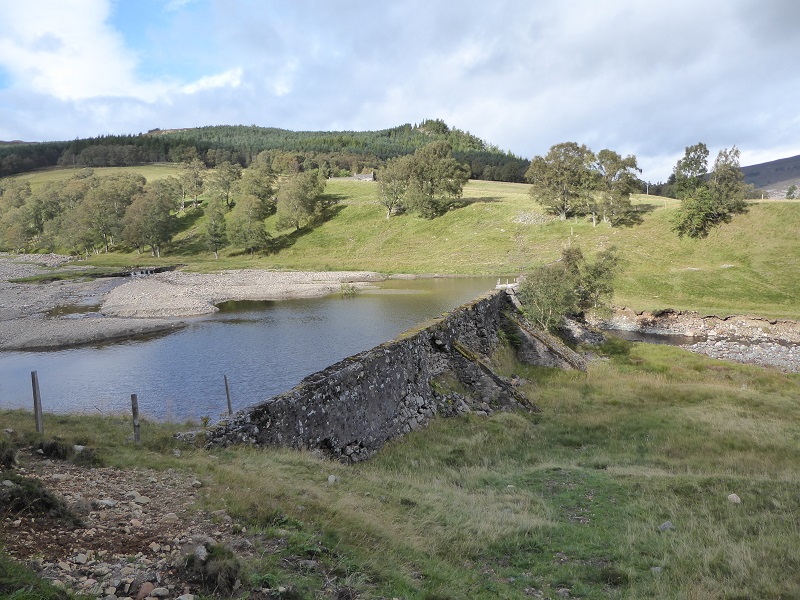
Historically there was a hydro scheme on the Corriemulzie burn which supplied power to Mar Lodge.
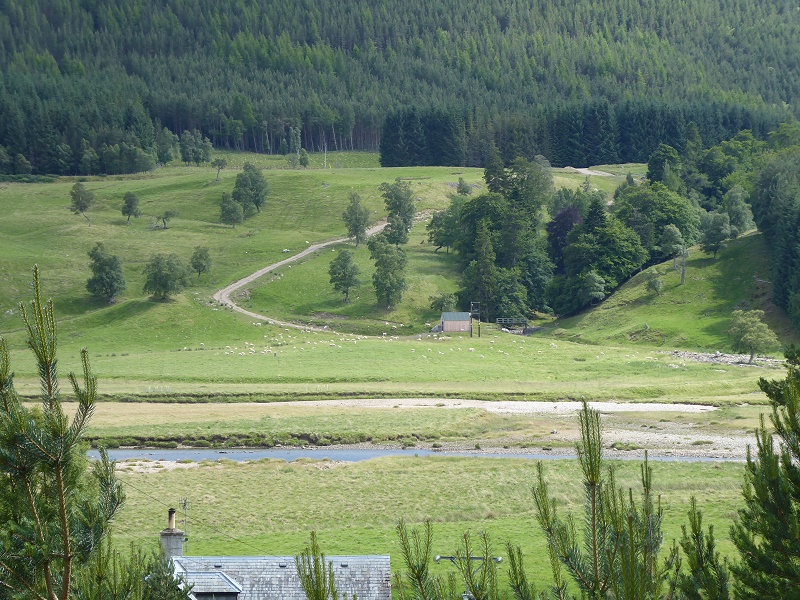
The new powerhouse sits by site of former powerhouse although the track to it, down from the Braemar to Linn of Dee Road, is new. In my view – and I realise this is just a matter of opinion – the wider landscape impact of the track is not a major issue. I did not revisit the track though last September there were both good things and bad about how the land around it had been restored.
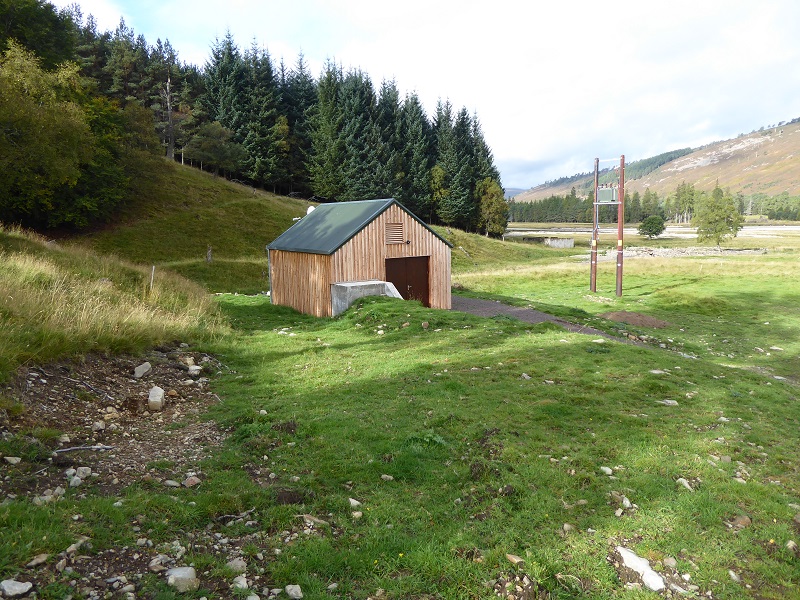 In design terms the power house is well located, close to bank and trees, and the turning area for vehicles is small. All positives. The ground above the pipeline had recovered quickly, with evidence of turfs having been stored and replaced. Incredible care needs to be taken with removal of turf and topsoil if all the surface area is to be re-covered in restoration and in this area there was not enough to use on the banks (bare patch left) though I suspect this has recovered by now.
In design terms the power house is well located, close to bank and trees, and the turning area for vehicles is small. All positives. The ground above the pipeline had recovered quickly, with evidence of turfs having been stored and replaced. Incredible care needs to be taken with removal of turf and topsoil if all the surface area is to be re-covered in restoration and in this area there was not enough to use on the banks (bare patch left) though I suspect this has recovered by now.
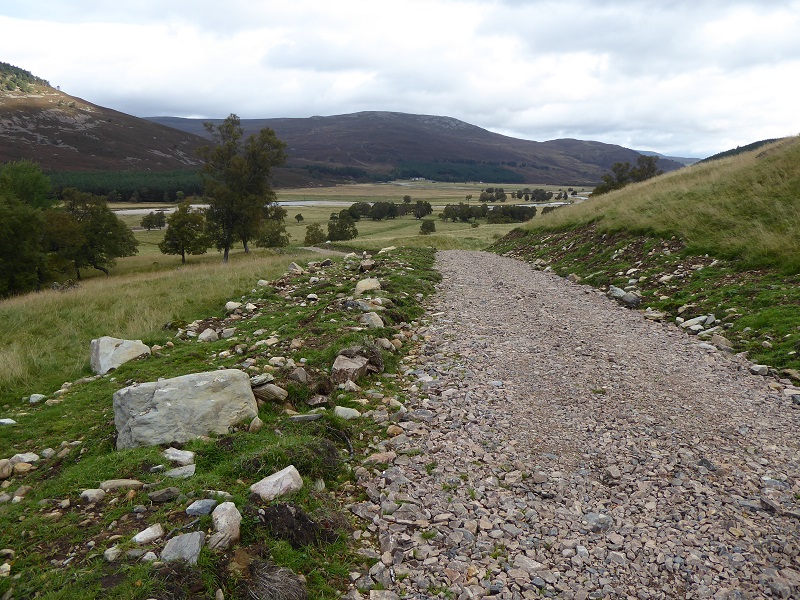
The track has been less well done, with large boulders left on the surface of what had previously been a grassy field. The bank on the right though is at a sufficiently low angle to recover quickly and a good example of track design.
The Corriemulzie hydro intake area
The main problem with the Corriemulzie scheme is around the main intake. It was not pristine prior to the hydro and the hill track and vehicle use had caused some needless damage.
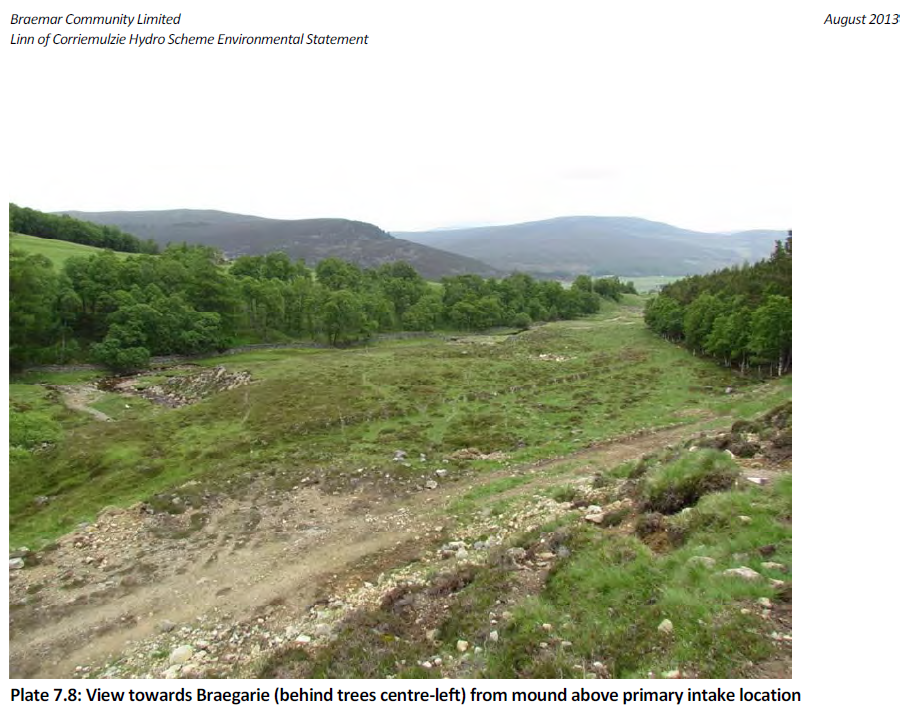
The planning however was a chance to restore past damage and the intake was intended to look like this:
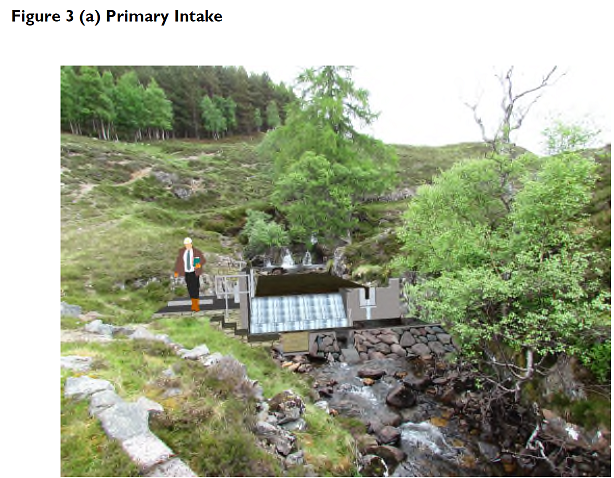
If this had been delivered, I would be congratulating Braemar Community Hydro and the Cairngorms National Park Authority whose landscape adviser had said “the location of intake is a small but very scenic a ‘gem’ of a location” and recommended the utmost care.
Unfortunately, what has happened is completely different to what was intended.
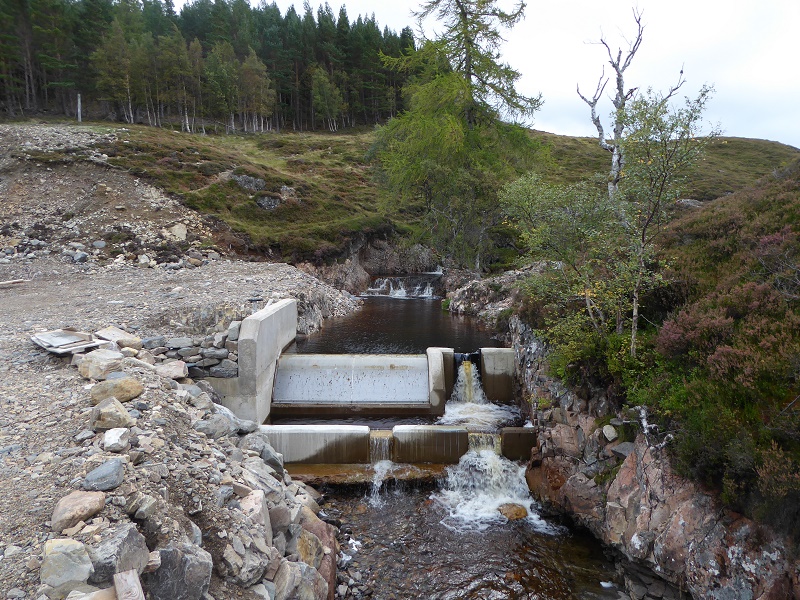

And this is an overview of how the area looks now:
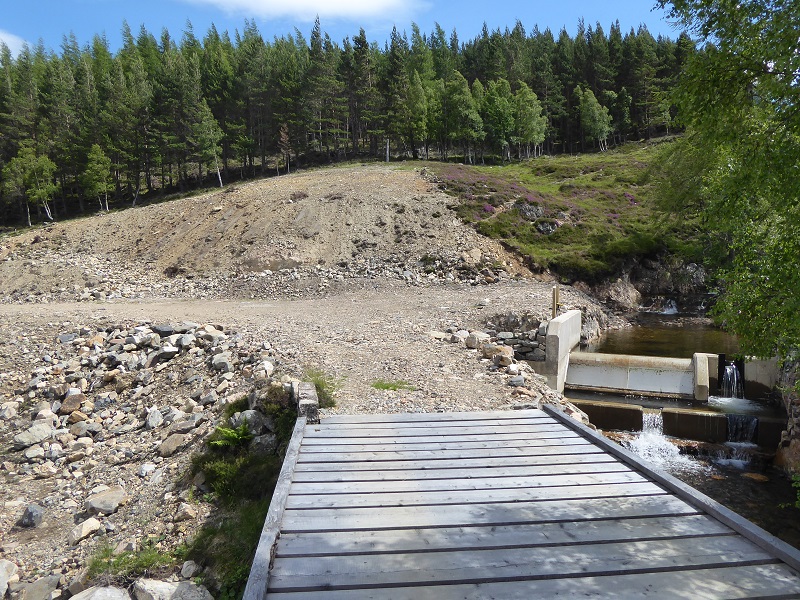
The fundamental issues here are:
- there has been no effective restoration of the bank along the burn;
- the bank on the hill was excavated and is far too steep to be restored;
- the track and turning area are far too wide.
While there had been obvious attempts at amelioration since September 2016 these have not in my view addressed the fundamental issues.
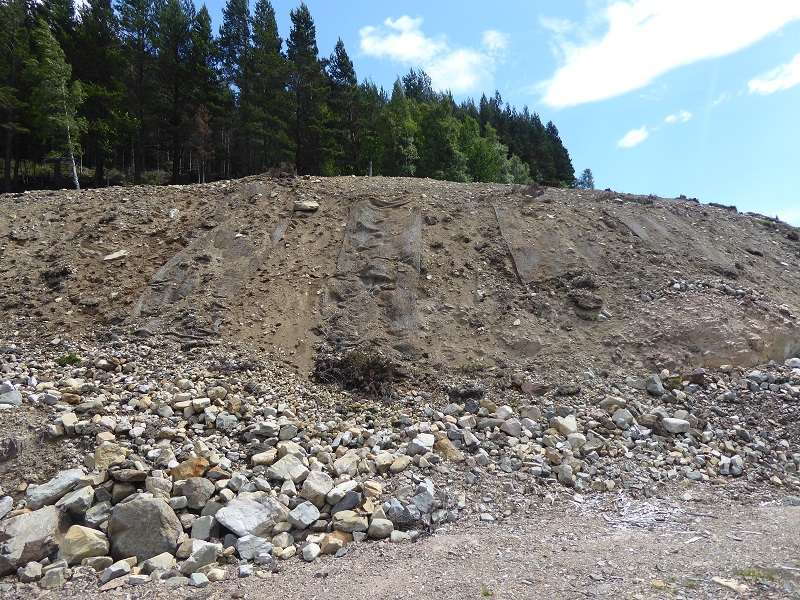 Four strips of fabric had been applied to the oversteep bank to reduce erosion but this has had no impact. There is no sign of vegetation re-establishing itself and the problems have been increased by deer (you can see hoof marks between 2nd and 3rd strips) walking down the slope.
Four strips of fabric had been applied to the oversteep bank to reduce erosion but this has had no impact. There is no sign of vegetation re-establishing itself and the problems have been increased by deer (you can see hoof marks between 2nd and 3rd strips) walking down the slope.
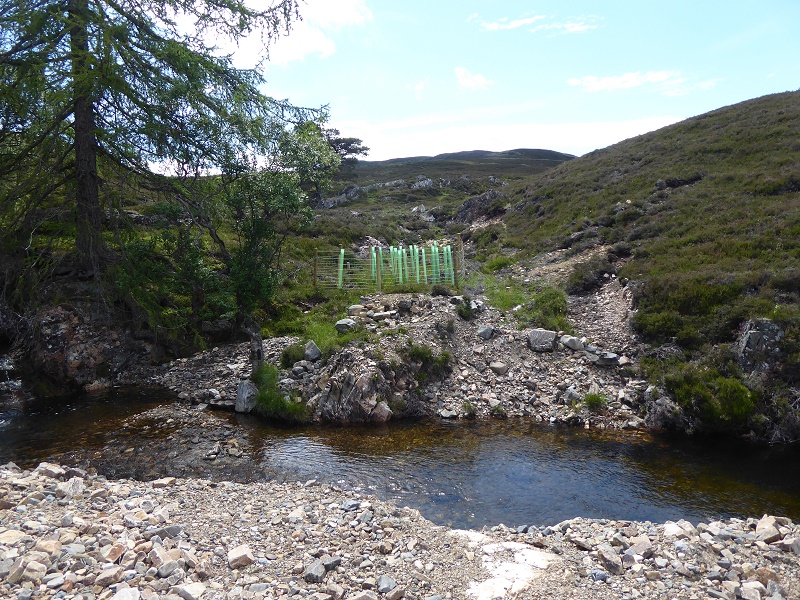
There has been “compensatory” tree planting but no attempt to restore vegetation to the bank of the burn. This should have been done months ago at the beginning of the growing season.
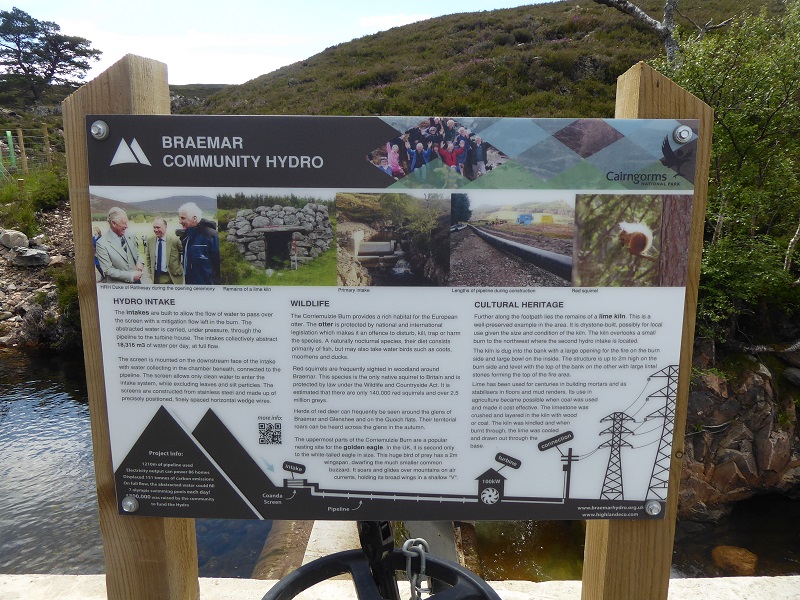
A new signboard has been erected by the intake. The line of pylons is rather ironic given CNPA’s opposition to the Beauly Denny and I wonder what Prince Charles, who opened the scheme, and talks so much about architectural standards and traditional landscapes thought about the destruction. Its as if, though, everyone at the official opening had their eyes shut.
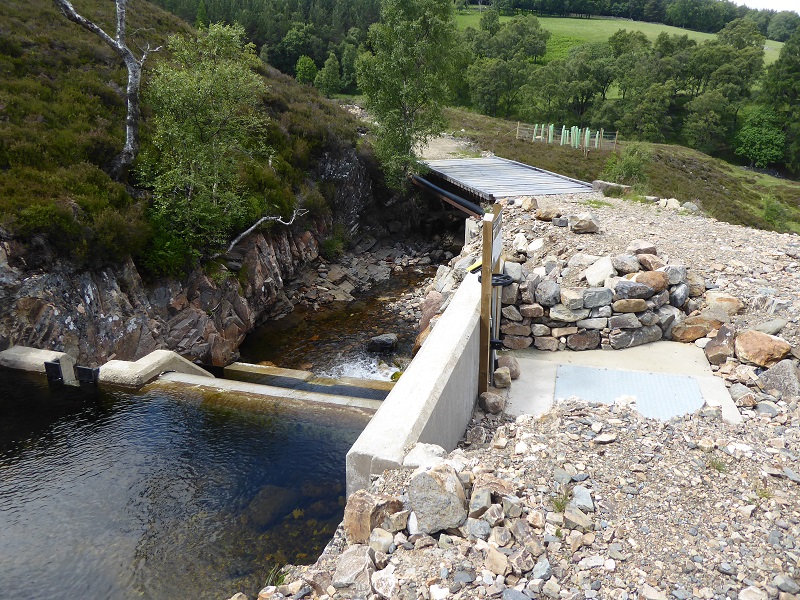 Despite the atrocious finishing along the bank and track, this photos shows some good things about the scheme. You can just see the pipe from the second hydro running below the bridge – you won’t see it unless you look out for it – and the CNPA told the developer there was no need to erect fencing around the intake. I agree. All that good design though counts for little if the destruction round about is not addressed.
Despite the atrocious finishing along the bank and track, this photos shows some good things about the scheme. You can just see the pipe from the second hydro running below the bridge – you won’t see it unless you look out for it – and the CNPA told the developer there was no need to erect fencing around the intake. I agree. All that good design though counts for little if the destruction round about is not addressed.
So what has gone wrong?
I have tried since the weekend to look through planning documents. There are pages of them, one document submitted by Braemar Community Hydro is over 200 pages long, and seems to cover everything except a description of the detailed work that was planned to construct the main intake. The CNPA landscape adviser drew attention to this in an appendix to the Committee Report and recommended further detailed plans were required before planning consent was given. The Committee however gave approval on condition these documents were produced but unfortunately these documents, if they were produced, are not on the CNPA website. It is possible therefore that the CNPA allowed this development to go ahead without a proper landscape plan for the intake area. If so, that in effect allowed the contractor to do what they wanted in the intake area and undermined all the other efforts staff had made to ensure this scheme was of the highest standard possible. One small mistake can have huge consequences.
However, I don’t think all the emphasis should be on paperwork, which is beyond the capacity of any community organisation to deliver and which means they have to put themselves in the hands of consultants. I suspect if there was a hole in the paperwork, Braemar Community Hydro did not appreciate this either.
A fundamental problem with the proliferation of hydro schemes is that monitoring their construction is not being properly resourced. I think if there had been someone properly qualified on site, the bank on the hillside would never have been excavated because it would have been only too obvious it could not be restored properly. The problem is our National Parks rely on developers appointing an Ecological Clerk of Works to do the supervision and these people are beholden to the developer/contractor who pay their wages – they are therefore not independent. It may also be the case – given the many failures to restore construction tracks – that they don’t have the right skills.
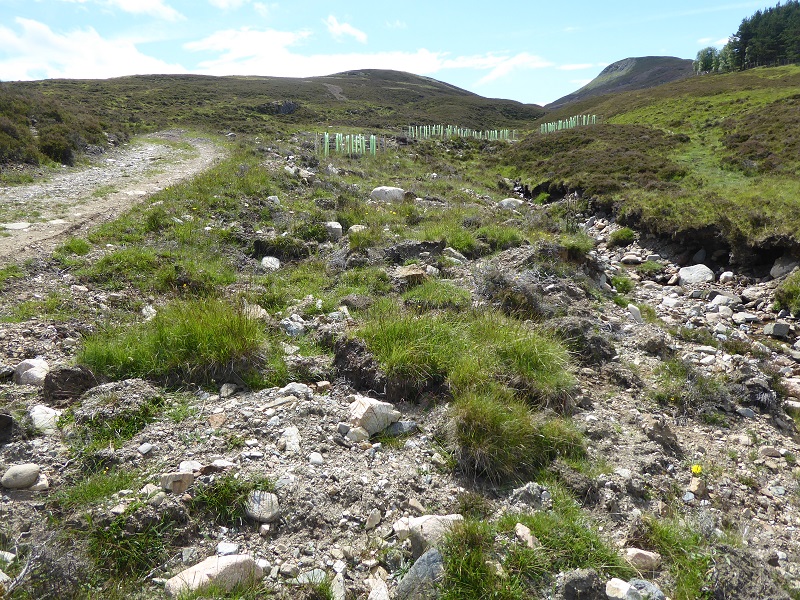
A related issue is that both our National Parks only appear to start proper monitoring once construction is almost complete. Here is what CNPA Chief Executive Grant Moir told me in January:
“CNPA staff noted various breaches at the site in April 2016 during a routine monitoring visit. The agent was immediately contacted by phone to express concern and also contacted in writing. CNPA staff and the agent for the development met on site in May 2016 to discuss how to reinstate or mitigate the unauthorised or unsatisfactory works. The agent provided an initial written programme of reinstatement works in June 2016 which the CNPA did not consider satisfactory”
What a commendable response and the contrast with the Loch Lomond and Trossachs National Park Authority who treat everything as a Freedom of Information Request is striking. The problem though is once the construction has gone wrong, and created unnecessary damage, this becomes very difficult and very expensive to put right. Our National Parks need to try and find a way of preventing problems rather than detecting them after the event.
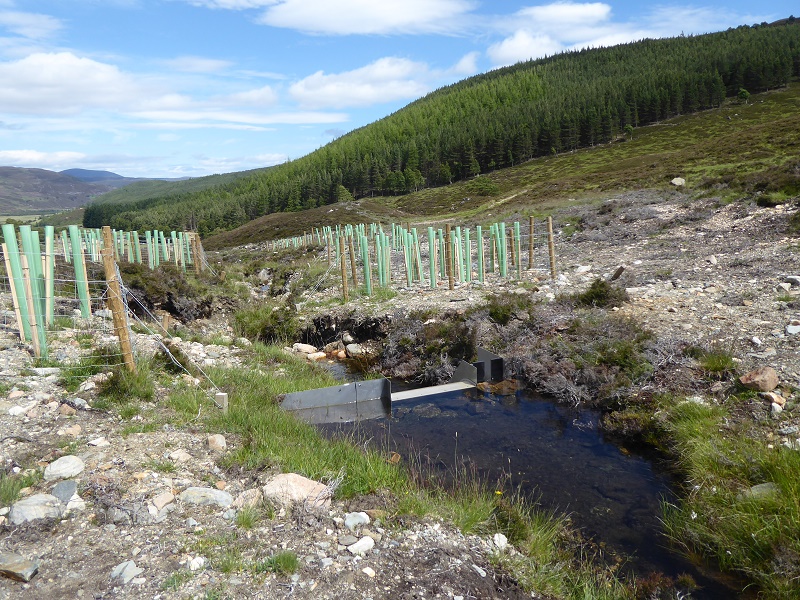
Lots of tree planting should not be seen as compensation for poor ground restoration work.
What needs to happen
I hope this post has demonstrated that the way the planning system operates at present, even when our National Parks’ have taken considerable and commendable efforts with hydro developments, they can go badly wrong.
The focus of the CNPA and Braemar Community Hydro needs to be around addressing the landscape damage around the first intake. I think that to remedy the damage will require considerable expertise and require money. If the contractor cannot be made liable, it means the shareholders for the hydro, who were expecting a 5-8% return (there is interesting information on the finances on the community hydro website), Mar Estate which is charging rent (and was responsible for previous damage in the area) and the community may have to wait for their return. It seems to people that all the people who were going to gain from this development have a collective responsibility to ensure that this is not at the expense of the landscape. Success would then be being able to promote this as being a nice place to go for a walk again – a “small gem” in the National Park – as it was in the past.
In terms of planning system failures, it seems to me these are twofold. First, not nearly enough emphasis is put on the landscape impact of construction prior to planning approval. Planning applications consider the wider impact on the landscape but not the more localised impact. Its hard to see the Corriemulzie intake from any distance but the local impact is huge. Our National Parks should be exemplars of good practice in this respect but they generally approve hydro schemes in principle without detailed Construction Method Statements. Then, once a scheme is approved in principle, its much harder for staff to influence and its probably less of a priority, because they are judged on the time it takes from planning application to approval. None of this is the fault of planning staff, its the system and that needs to change.
Second, the focus of monitoring needs to shift from the end stage of the construction to the beginning and be independent of both developer and contractor. This would prevent problems arising. For example, if our National Parks were ensuring all vegetation was properly removed and stored before pipelines were dug or tracks created or broadened, restoration would then be far more effective.
For this to happen though, our National Parks, like all our public authorities, need to be properly resourced.
Lastly, it would be good, given what I see as their good intentions, if the CNPA, Braemar Community Hydro and the other main players had a proper discussion, a post mortem if you like, about what lessons might be learned and then publicised this so they could be used to inform the development of hydro schemes, both community and commercial, in future.